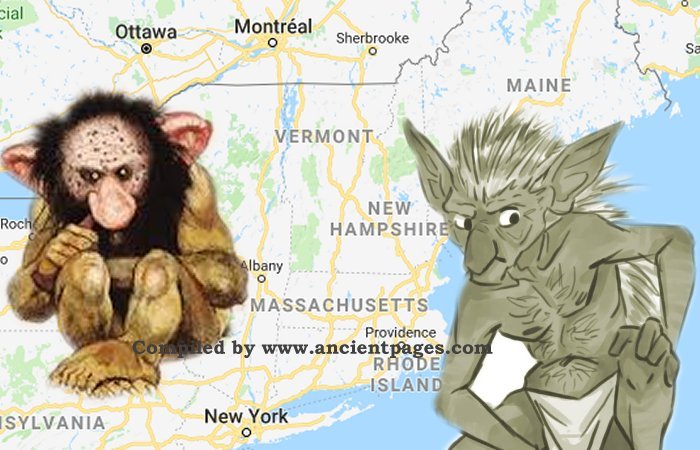Chaneques: Mischievous Legendary Tricksters In Mexican Folklore
A. Sutherland - AncientPages.com - Mysterious, magical individuals called 'chaneques' are famous in Mexican folklore; however, they also have a lot in common with the Pukwudgies, only knee-high or smaller, grey-faced forest people with large ears, as described in Algonquian folklore.
They are also similar in their behavior to Alux, a little trickster in Mayan folklore responsible for 'bad things and yet protects the field at night, summons rain, and helps grow the corn and bring wealth and good fortune.
In some contemporary legends, the chaneques (from Nahuatl, "those who live in dangerous places" or "owners of the house") are described as children with faces from elderly men or women. Otherwise, they are no more than one meter tall, have feet in reverse, a deformed body, sometimes lack a left ear, and laugh like a child. In other legends, they have huge heads and chocolate-colored skin.
White And Black Chaneques And Isolated Places
Tradition has it that the chaneques inhabit deep forests, mountains, abandoned ruins, springs, wildernesses, and ditches and belong in the underworld. Therefore, such places were traditionally avoided, and the spirits were associated with the evil powers. Who or what are the chaneques?
Are they dwarves with children's voices and faces? No one knows for sure. In the beliefs of ancient people, the chaneques are friendly and play pranks like mischievous children usually do by shaking hammocks, scaring animals or adults, throwing stones or dishes in the kitchen, hiding objects in the houses, and more.
Despite their playful nature, they are not so bad. Sometimes, they live in crops or under the same roof as people as long as these troublesome spirits do not take people's money, jewelry, or important papers or keys.
The chaneques remind us of the magical little forest people known as Pukwudgies. It's always advisable to be aware of their presence without disturbing them because many chaneques prefer to keep their distance.
Depending on local beliefs, there are good and bad individuals among these spirits. The good ones were similar to the elves, traced back to Norse, Celtic, and Germanic myths and legends, describing them as young, white, pleasant-looking, and bringing luck with them. On the other hand, the black ones had ugly deformities and brought darkness and diseases to the people.
One of the central beliefs related to the chaneques is that they pretend to be children who intentionally attract people to their world. They can even scare people to death; in that case, the soul leaves the body immediately captured by the chaneques who lock it up underground.
Tradition says that if the victim does not manage to recover his soul through a specific ritual, he falls ill and dies within a short time.
Chaneque Spirits In Ancient Catholic Beliefs And Contemporary Legends
In the Catholic beliefs of the Mexican people, the chaneques are the souls of the children who died without Christian baptism and probably originated from pre-colonial times. They are little demons who prey on people wandering alone in the forest or impenetrable jungles of Mexico.
Confusing people, they express their hostility to make them lost and prey on them at night, even eat them.
They can make people lose three to seven days, so they cannot recall anything that happened to them. Then, the victims realize they have been kidnapped by the malicious chaneques and taken to their afterlife, which is only accessed through a dry trunk of the ceiba tree, a sacred tree of most civilizations of Mesoamerica, including Mixtec, Aztec, and Maya. Long ago, the people believed that the ceiba grows deep into the underworld.
Even today, there are many testimonies of people who disappeared in the deep forests of central and southern Mexico.
Written by – A. Sutherland - AncientPages.com Senior Staff Write
Updated on February 8, 2024
Copyright © AncientPages.com All rights reserved. This material may not be published, broadcast, rewritten or redistributed in whole or part without the express written permission of AncientPages.com
More From Ancient Pages
-
 Curious Alien-Looking Slit Gongs Figures From Vanuatu Allowed Villagers To Communicate
Ancient Traditions And Customs | Sep 24, 2018
Curious Alien-Looking Slit Gongs Figures From Vanuatu Allowed Villagers To Communicate
Ancient Traditions And Customs | Sep 24, 2018 -
 Tests On Tutankhamun’s Tomb: Non-Invasive Radar Search For Nefertiti To Start Thursday
Archaeology | Nov 23, 2015
Tests On Tutankhamun’s Tomb: Non-Invasive Radar Search For Nefertiti To Start Thursday
Archaeology | Nov 23, 2015 -
 Mysterious And Frightening Sculptor’s Cave Of The Picts Reconstructed In 3D Model
Archaeology | Dec 10, 2017
Mysterious And Frightening Sculptor’s Cave Of The Picts Reconstructed In 3D Model
Archaeology | Dec 10, 2017 -
 3,000-Year-Old Stone Scarab Seal Depicting A Pharaoh Discovered In Israel
Archaeology | Dec 2, 2022
3,000-Year-Old Stone Scarab Seal Depicting A Pharaoh Discovered In Israel
Archaeology | Dec 2, 2022 -
 Lincolnshire’s Prehistoric Henge And A Sacred Site Dating Back Hundreds Of Years
Archaeology | Apr 6, 2024
Lincolnshire’s Prehistoric Henge And A Sacred Site Dating Back Hundreds Of Years
Archaeology | Apr 6, 2024 -
 Mystery Of Ancient “Magical” Mirrors – Some Of The Strangest Objects In The World
Ancient Mysteries | Apr 21, 2011
Mystery Of Ancient “Magical” Mirrors – Some Of The Strangest Objects In The World
Ancient Mysteries | Apr 21, 2011 -
 Rare Gold Foils Found In Ancient Egyptian Tombs At Tel El-Deir In New Damietta
Archaeology | Jul 24, 2024
Rare Gold Foils Found In Ancient Egyptian Tombs At Tel El-Deir In New Damietta
Archaeology | Jul 24, 2024 -
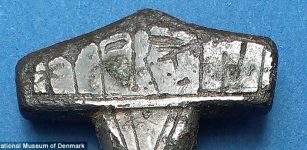 Remarkable Discovery Of Unusual “Hammer Of Thor” Finally Solves An Ancient Mystery
Archaeology | Jul 2, 2014
Remarkable Discovery Of Unusual “Hammer Of Thor” Finally Solves An Ancient Mystery
Archaeology | Jul 2, 2014 -
 Underwater Excavations: Greek And Danish Archaeologists Research Ancient Harbor Town Lechaion
Archaeology | Dec 25, 2015
Underwater Excavations: Greek And Danish Archaeologists Research Ancient Harbor Town Lechaion
Archaeology | Dec 25, 2015 -
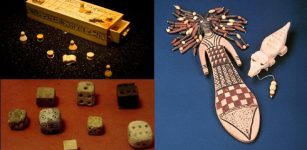 Ancient Egyptian Toys And Games In Focus
Featured Stories | Jan 15, 2016
Ancient Egyptian Toys And Games In Focus
Featured Stories | Jan 15, 2016 -
 DNA Identifies Historical Remains Of George Washington’s Relatives
DNA | Mar 29, 2024
DNA Identifies Historical Remains Of George Washington’s Relatives
DNA | Mar 29, 2024 -
 Resourceful Neanderthals Could Dive 13ft If Necessary To Collect Shells
Archaeology | Jan 16, 2020
Resourceful Neanderthals Could Dive 13ft If Necessary To Collect Shells
Archaeology | Jan 16, 2020 -
 16 Meters Long Ancient Papyrus With Spells From The Book Of The Dead Found In Saqqara
Archaeology | Jan 19, 2023
16 Meters Long Ancient Papyrus With Spells From The Book Of The Dead Found In Saqqara
Archaeology | Jan 19, 2023 -
 1,000-Year-Old Coin And Other Finds Unearthed During Excavations At Carrignacurra Castle in Cork
Archaeology | Oct 6, 2022
1,000-Year-Old Coin And Other Finds Unearthed During Excavations At Carrignacurra Castle in Cork
Archaeology | Oct 6, 2022 -
 The Battle Of The ‘Cloudships’ – Strange And Unexplained Sightings In The Skies
Featured Stories | Jun 14, 2019
The Battle Of The ‘Cloudships’ – Strange And Unexplained Sightings In The Skies
Featured Stories | Jun 14, 2019 -
 Can This Ancient Underwater Graveyard Solve The Mystery Of The Great Flood And Noah’s Ark?
Archaeology | Oct 23, 2019
Can This Ancient Underwater Graveyard Solve The Mystery Of The Great Flood And Noah’s Ark?
Archaeology | Oct 23, 2019 -
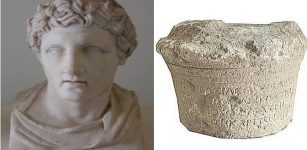 2,000-Year Old Engraved Kurdistan Tablet Referring To A Hellenistic Ruler Demetrius – Analyzed
Archaeology | Dec 14, 2020
2,000-Year Old Engraved Kurdistan Tablet Referring To A Hellenistic Ruler Demetrius – Analyzed
Archaeology | Dec 14, 2020 -
 Is A Gigantic Ancient City Hidden Underwater In The Bermuda Triangle?
Featured Stories | Jul 8, 2014
Is A Gigantic Ancient City Hidden Underwater In The Bermuda Triangle?
Featured Stories | Jul 8, 2014 -
 Did Human Nature’s Dark Side Help Us Spread Across The World?
Archaeology | Nov 25, 2015
Did Human Nature’s Dark Side Help Us Spread Across The World?
Archaeology | Nov 25, 2015 -
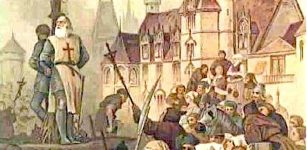 On This Day In History: Knights Templars’ Jacques de Molay Burned At The Stake – On Mar 18, 1314
News | Mar 18, 2017
On This Day In History: Knights Templars’ Jacques de Molay Burned At The Stake – On Mar 18, 1314
News | Mar 18, 2017


